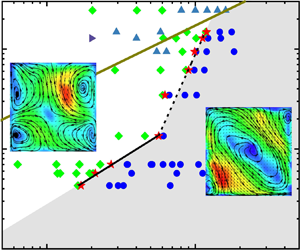No CrossRef data available.
Published online by Cambridge University Press: 22 August 2024

To date, a comprehensive understanding of the influence of the Prandtl number ( $Pr$) on flow topology in turbulent Rayleigh–Bénard convection (RBC) remains elusive. In this study, we present an experimental investigation into the evolution of flow topology in quasi-two-dimensional turbulent RBC with
$Pr$) on flow topology in turbulent Rayleigh–Bénard convection (RBC) remains elusive. In this study, we present an experimental investigation into the evolution of flow topology in quasi-two-dimensional turbulent RBC with  $7.0 \leq Pr \leq 244.2$ and
$7.0 \leq Pr \leq 244.2$ and  $2.03\times 10^{8} \leq Ra \leq 2.81\times 10^{9}$. Particle image velocimetry (PIV) measurements reveal the flow transitions from multiple-roll state to single-roll state with increasing
$2.03\times 10^{8} \leq Ra \leq 2.81\times 10^{9}$. Particle image velocimetry (PIV) measurements reveal the flow transitions from multiple-roll state to single-roll state with increasing  $Ra$, and the transition is hindered with increasing
$Ra$, and the transition is hindered with increasing  $Pr$, i.e. the transitional Rayleigh number
$Pr$, i.e. the transitional Rayleigh number  $Ra_t$ increases with
$Ra_t$ increases with  $Pr$. We mapped out a phase diagram on the flow topology change on
$Pr$. We mapped out a phase diagram on the flow topology change on  $Ra$ and
$Ra$ and  $Pr$, and identified the scaling of
$Pr$, and identified the scaling of  $Ra_t$ on
$Ra_t$ on  $Pr$:
$Pr$:  $Ra_t \sim Pr^{0.93}$ in the low
$Ra_t \sim Pr^{0.93}$ in the low  $Pr$ range, and
$Pr$ range, and  $Ra_t \sim Pr^{3.3}$ in the high
$Ra_t \sim Pr^{3.3}$ in the high  $Pr$ range. The scaling in the low
$Pr$ range. The scaling in the low  $Pr$ range is consistent with the model of balance of energy dissipation time and plume travel time that we proposed in our previous study, while the scaling in the high
$Pr$ range is consistent with the model of balance of energy dissipation time and plume travel time that we proposed in our previous study, while the scaling in the high  $Pr$ range implies a new governing mechanism. For the first time, the scaling of
$Pr$ range implies a new governing mechanism. For the first time, the scaling of  $Re$ on
$Re$ on  $Ra$ and
$Ra$ and  $Pr$ is acquired through full-field PIV velocity measurement,
$Pr$ is acquired through full-field PIV velocity measurement,  $Re \sim Ra^{0.63}\,Pr^{-0.87}$. We also propose that increasing horizontal velocity promotes the formation of the large-scale circulation (LSC), especially for the high
$Re \sim Ra^{0.63}\,Pr^{-0.87}$. We also propose that increasing horizontal velocity promotes the formation of the large-scale circulation (LSC), especially for the high  $Pr$ case. Our proposal was verified by achieving LSC through introducing horizontal driving force
$Pr$ case. Our proposal was verified by achieving LSC through introducing horizontal driving force  $Ra_H$ by tilting the convection cell with a small angle.
$Ra_H$ by tilting the convection cell with a small angle.